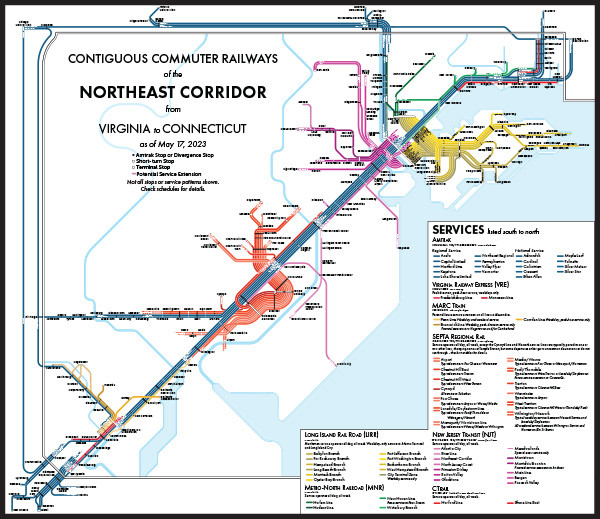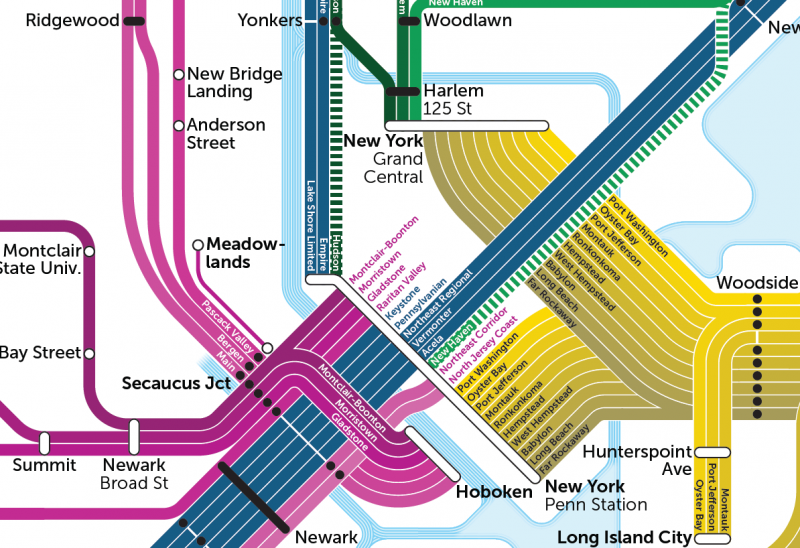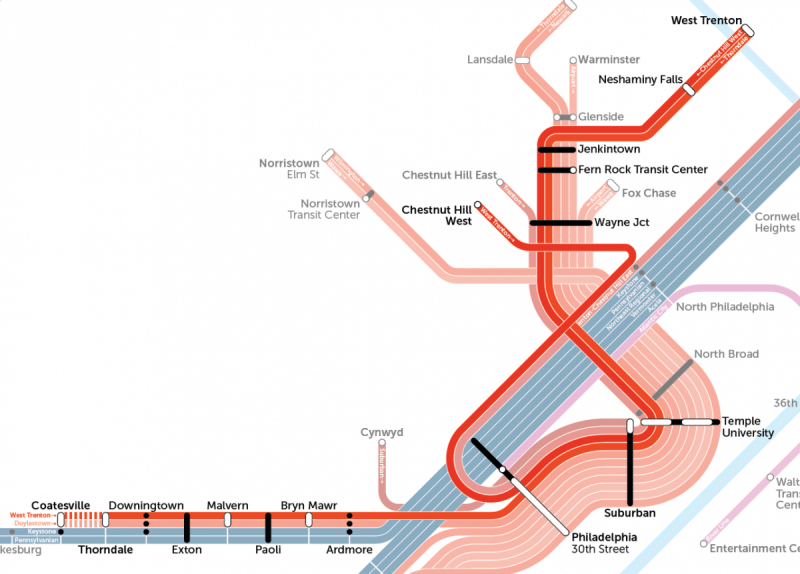This mega-map shows how MARC’s extension to Newark links us to a much broader region

A map of contiguous commuter railways of the Northeast Corridor from Virginia to Connecticut. View the full map.
If you’ve ever thought about taking a train trip from Frederick to Atlantic City but want to avoid Amtrak due to some unspeakable past misdeed (I’d give examples but, well, they’re unspeakable), you might finally have your chance.
MARC is finally proposing extending weekday service to Newark, Delaware, giving commuters and other travelers a chance to transfer between SEPTA and MARC for the first time ever and opening up through travel in a way that has never been possible before.
The proposed MARC extension from Perryville, Maryland, to Newark, Delaware, is depicted in yellow. 
The connection would help travelers in Baltimore’s northern exurbs better use transit to get to work in Wilmington and points north, at least during weekdays. This is a good thing, if only because commuter rail tends to be cheaper than Amtrak.
Commuter rail is a fuzzy concept, but in the United States it generally means rail transportation that is primarily:
- Intraregional;
- Operates between a regional core and its suburbs rather than mostly within the core city; and
- Could, in theory, operate alongside freight rail (in contrast to metro systems or light rail).
It’s fuzzy because these are artificial distinctions, and so some systems like PATH or PATCO could theoretically qualify, but for the purposes of this map do not.
Now that it seems like that MARC connection to Delaware is going to happen, it got us wondering: how far could you travel on commuter rail, anyway?
I designed a map showing exactly that. To that end, the map only shows transfer stations, Amtrak stations, and terminals. (While not technically a commuter railroad, Amtrak often functions as a stopgap during service outages, and forms the system’s intercity backbone.)
The answer? Linking MARC and SEPTA will make it possible to take a commuter rail trip from Spotsylvania, Virginia, to Springfield, Massachusetts.
But the map also tells us so much more. See the high-resolution version, and read on.
Every city is different
Creating this map required a deep dive into the operations of each system represented, which gave me a chance to do some basic comparisons between the systems.
I was surprised by how robust commuter rail is outside of our region. Every Northeast operator except Virginia Railway Express (VRE) runs service all day, all week, in both directions. MARC used to be in the low-service camp with VRE, but the Penn Line provides an all-week level of service. On a national scale, VRE’s service is not unusual: Seattle’s Sounder and San Jose’s VIA Rail have similar operations. Regionally, however, it stands out.
Another thing is how very “20th century” the Northeast’s rail system is. Except for Philadelphia and Baltimore, no city has service that runs through its core. Long Island Rail Road, New Jersey Transit, Metro-North, MARC, VRE, and CTrail all dead-end in the centers of their biggest cities.
NJ Transit, Metro-North, and Long Island Rail Road lines are seen dead-ending at New York’s Grand Central Station and Penn Station. 
Most railroads in the United States used to operate this way, with famous and luxurious stations functioning as the end of the line and forcing transfers for travelers heading further. This was thanks mostly to the fact that systems tended to be built by independent companies competing with one another. If MARC finally starts running trains through Washington Union Station, MARC would be doing something most do not.
One rail system that has significantly improved over the old days of railroading is SEPTA.
SEPTA's West Trenton Line, highlighted here, typically runs through to either the Chestnut Hill West Line or Thorndale/Paoli Line. View the full map. 
Philadelphia’s system operates its lines up to but not through the city’s center (so the Airport Line might just run to 30th Street), but almost all the trains continue on to another line (so the Airport Line’s trains change to a different line at 30th Street, sort of like if the Silver Line only ran up to East Falls Church, but some Silver Line trains continued on rebranded as Orange Line trains).
After doing a little research, it became clear that each SEPTA line was almost always paired with one or two other lines, providing a lot of connectivity for passengers. This is thanks to the 1984 Center City Tunnel, which linked what were once Pennsylvania Railroad and Reading Company territories.
So what?
It is useful to know, rather than simply intuit, that there are extensive railway systems throughout the Northeast beyond Amtrak – you can take trains to Montauk or Norristown without ever setting foot on a bus. It is also useful to know what the Baltimore-DC region might aspire to.
Unlike the paucity of rail service in Baltimore and DC, the rest of the Northeast has networks with significantly different transit histories and operating philosophies. Many of these other systems have run similar passenger service for a century or more; these days, Baltimore’s old rail lines are mostly freight-only and serve industrial areas. Washington’s passenger railroads mostly survived, but the city only started booming in the twilight of passenger railroading in the 1940s.
Though DC and Maryland railroads are mostly stuck as tenants, operating at the whims of host railroads – CSX, Norfolk Southern, and Amtrak – rather than controlling their own tracks, we can, and should, seek inspiration from even the imperfect systems of Philadelphia, New Jersey, and New York. Providing consistent, fast service like the Long Island Rail Road or SEPTA would provide further nodes for transit-oriented development in the region and link our often disparate, and disconnected, suburbs. If we play our cards very well, perhaps we could serve as inspiration, in turn, to them.
Author’s note: Thank you to the many people who weighed in with feedback on this map of the contiguous commuter railways of the Northeast Corridor, including Liam Blank, John Boyle, Nicole Brunet, Connor Descheemaker, Eric Lundy, and Peter Tomao.
